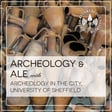
1860-1914: Making the Armaments Centre of the World with Chris Corker - Ep 37
Archaeology and Ale is a monthly series of talks presented by Archaeology in the City, part of the University of Sheffield Archaeology Department’s outreach programme. This month we are proud to host Chris Corker speaking on "Making the Armaments Centre of the World (1860-1914)". This talk took place on Thursday, March 25th, 2021, online via Google Meets.
Chris is a business historian and lecturer in Management at the York Management School. He has researched the steel and armaments industry in Sheffield for over a decade and is now branching into research on the metalworking industries in the Hallamshire area from the late 13th Century to the present. He completed his PhD in business history at Sheffield Hallam University in December 2016, titled ‘The Business and Technology of the Sheffield Armaments Industry 1900-1930’. The following year he was awarded the annual Coleman Prize for excellence in new business history research by the Association of Business Historians for his doctoral work. In 2019 he was awarded an Emerald Literati award for his work in the Journal of Management History, and in 2020 was awarded a Vice Chancellors Teaching Award from the University of York for an outstanding contribution to teaching and learning. On Remembrance Sunday in 2018 Chris curated the ‘Sheffield’s Great War’ event at the Sheffield City Hall Memorial Hall in aid of the Royal British Legion, and also worked as an advisor to the ‘Made in Great Britain’ series which aired the same year on BBC2. In the last two years Chris has presented research on Sheffield steel and armaments companies at international business and economic history conferences in Montreal, Canada; Oklahoma City, USA; Detroit, USA; Jyvaskyla, Finland; and across the UK.
For more information about Archaeology in the City’s events and opportunities to get involved, please email archaeologyinthecity@sheffield.ac.uk or visit our website at archinthecity.wordpress.com. You can also find us on Twitter (@archinthecity), Instagram (@archaeointhecity), or Facebook (@archinthecity)
Affiliates